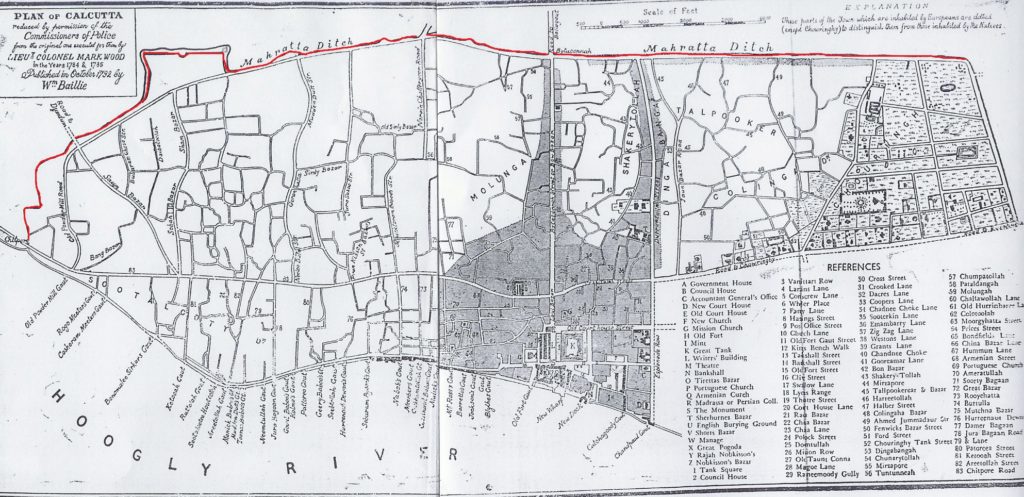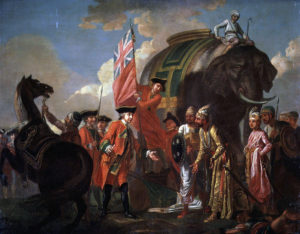The three villages of Sutanuti, Govindapur and Kalikata were part of a Khas Mahal or Imperial Jagir or an estate belonging to the Mughal emperor, whose Jagirdari rights were held by the Sabarna Roy Choudhury family. In 1698A.D. the Mughal Emperor gave permission of unrestricted trade in Kolkata to the British. They ultimately got The Right to Rent or lease the three villages from Sabarna Roy Choudhury for an annual rent of Rupees Thirteen Hundred. By 1700A.D. East India Company declared Kolkata to be the Presidency City. They started building the Old Fort William, which was completed by 1706A.D.
Sovaram moved to Govindapur in Kolkata and built a house there. He soon became a notable business man in Kolkata and earned a good name with the British. He became a millionaire by supplying textile to the East India Company.
Bourgeois plunder and the Maratha Ditch
During 1741A.D. to 1751A.D., the spectra of Bargi invasion and large-scale plundering of the countryside dominated the western part of Bengal. Maratha soldiers were known as the Bargis who tortured Bengal, Bihar and Odisha inhabitants in the name of tax collection. They created quite a havoc in Bardhhaman, Nadia, Murshidabad, Midnapur and in other districts apart from Kolkata.
People flocked to Kolkata finding it to be a safer haven under the East India Company, who in turn planned to build a seven-mile-long ditch around the city for further fortification. However, only 3 miles long ditch was constructed starting from Shyambazar to Maidan in present Kolkata. It was 80 hands broad and the depth was 6 to 14 feet. Three Thousand workers worked for months to create the 3 mile canal.
The cost of building the ditch went up to rupees twenty five thousand. This cost was borne by the Sovaram Bysack, Baishnab Charan Sett and other notable businessmen along with the British to protect the city from the Bargi attack.

Battle of Plassey—it all began with a plunder
In 1756A.D, Sovaram once again suffered a loss—this time that of his house, which was attacked by Siraz-ud-Daulah’s army.
Siraz-ud-Daula with his army attacked Calcutta to stop further fortification by the British. The old fort William was attacked and demolished completely. His army also damaged and plundered the houses of the natives around the area. Among them, was Sovaram’s house.
The British quickly regained power and in April’ 1757A.D., within 6 months, Robert Clive, the commander-in-chief of the British, conspired and bribed Mir Zafar, the commander-in-chief of the Nawab along with Jagat Seth, a businessman from Kasimbazar, to defeat the Nawab in the battle of Plassey. He also promised Mir Zafar to make him the next Nawab of Bengal against this support.

A pact was made amongst Mir Zafar and the East India Company on the above understanding. One of the clauses of the pact was to recover the losses due to the attack of Siraz-ud-Daulah in 1756A.D. The clause stated that the East India Company would get rupees one crore, British inhabitants would get rupees Fifty lakh and the natives who had also suffered losses would get rupees Twenty Seven lakhs from the new Nawab.
After the battle of Plassey, the Company appointed 13 commissioners to apportion the restitution money amongst the native sufferers. However, the commission only distributed rupees Ten Lakhs Twenty Five Thousand Seven Hundred and Twenty Six amongst the natives. Sovaram Bysack had received rupees Three Lakh Seventy Five Thousand, a notable sum at that time.

Do read about his benevolence in the Episode 3!







When I grew up in Calcutta, I was the West Bengal Cycling Champion in 1963 and was a member of the Cycling Club called Bysack’s Gymnasium. It was run by the three Bysack brothers – Netai, Promode and Amode. Netai was the India Cycling champion for quite a number of years – he went to the 1948; 1952 and 1956 Olympic games representing India. I was privileged to have been trained by him. However because I was studying at IIT – Kharagpur from 1958-62, my cycling career did not blossom as it could have. But that is another story. I left Calcutta in 1963 when the India China border war was on.
My interest in this story about Sovaram Bysack is because I used to spend a lot of time at 14/3, Sovaram Bysack St. the home of the Bysack family. Happy memories
I now live in the UK.
Am proud to have been awarded the Distinguished Alumnus Award of IIT – Kharagpur in 2015.
Great to hear from you Chan. I will send you an email so that we can connect on this.
Its indeed a pleasure to see your post today. I am Pijush Bysack, youngest son of Late Promode Chanda Bysack. I used to hear a lot about you from my father. Really love to see your post.
Its indeed a pleasure to see your post today. I am Pijush Bysack, youngest son of Late Promode Chanda Bysack. I used to hear a lot about you from my father.